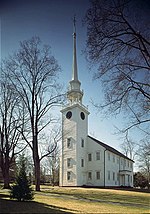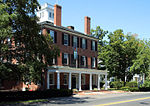Gen. George Cowles House
Historic district contributing properties in ConnecticutHouses completed in 1803Houses in Farmington, ConnecticutHouses on the National Register of Historic Places in ConnecticutNRHP infobox with nocat ... and 1 more
National Register of Historic Places in Hartford County, Connecticut

The Gen. George Cowles House, also known as the Solomon Cowles House, is a historic house at 130 Main Street in Farmington, Connecticut. Built in 1803, it is a prominent local example of Federal style architecture in brick, built for a prominent local family. The house was listed on the National Register of Historic Places on May 11, 1982.
Excerpt from the Wikipedia article Gen. George Cowles House (License: CC BY-SA 3.0, Authors, Images).Gen. George Cowles House
Winchell Smith Drive,
Geographical coordinates (GPS) Address Nearby Places Show on map
Geographical coordinates (GPS)
| Latitude | Longitude |
|---|---|
| N 41.7175 ° | E -72.835833333333 ° |
Address
Winchell Smith Drive 48
06032
Connecticut, United States
Open on Google Maps









